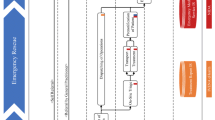Abstract
Introduction
The objective of this paper is to present complementary views of the activity of the emergency department for a specific group of patients. Once validated, these views will be used as decision support tools for better managing the department and providing better care delivery for this population. The views are produced from the data stored in Healthcare Information Systems that correspond potentially to a vast source of information for supporting decisions on management or public health issues.
Method
The study focuses on two groups of patients: the elderly population (over 75 years old) and the under 75 year old patients, at the Rennes hospital. The validation of the views is performed by comparing results for the two distinct groups. Relevant data were extracted from the Emergency Department database. Several analysis (like cusum chart) and representation tools (Graphviz) were used to study the patients’ pathways, the dynamics of arrivals and the patients’ characteristics.
Results
The representations provided a synthetic, global and comprehensive view of the department activities, to the satisfaction of the clinicians. The study showed that ICD-10 coding, assigned at the patient’s departure from the emergency department hence from all available known clinical data, is not appropriate for the elderly population as these patients are mainly diagnosed by “symptoms” and several solutions are proposed. Finally, it is stressed out that a proper delivery of care to elderly patients should require some level of scheduling in the emergency department that is by essence characterized by its non scheduled activity.






Similar content being viewed by others
References
Graber MA, VanScoy D (2003) How well does decision support software perform in the emergency department. Emerg Med J 20(5):426–428, Sep
Ceglowski R, Churilov L, Wassertheil J (2005) Facilitating decision support in Hospital Emergency Departments: a process-oriented perspective, in Proceedings of the 13th European Conference on Information Systems. Regensburg, Germany
Farion KJ, Michalowski W, Rubin S, Wilk S, Correll R, Gaboury I (2008) Prospective evaluation of the MET-AP system providing triage plans for acute pediatric abdominal pain. Int J Med Inform 77(3):208–218
Burns CM, Bennett CJ, Myers CT, Ward M (2005) The use of cusum analysis in the early detection and management of hospital bed occupancy crises. Med J Aust 183:291–294
Muscatello DJ, Churches T, Kaldor J, Zheng W, Chiu C, Correll P, Jorm L (2005) An automated, broad-based, near real-time public health surveillance system using presentations to hospital Emergency Departments in New South Wales, Australia. BMC Public Health 5:141
Pascal M, Laaidi K, Ledrans M, Baffert E, Caserio-Schonemann C, Le Tertre A, Manach J, Medina S, Rudant J, Empereur-Bissonnet P (2006) France’s heat health watch warning system. Int J Biometeorol 50:144–153
Shtatland E, Kleinman K, Cain E (2006) Biosurveillance and outbreak detection using the ARIMA and logistic procedures, SUGI’31 Proceeding, San Francisco, CA, USA, March 26–29
Sibanda T, Sibanda N (2007) The cusum chart method as a tool for continuous monitoring of clinical outcomes using routinely collected data. BMC Medical Research Methodology 7:46
Jay N, Napoli A, Kohler F (2006) Cancer patient flows discovery in DRG databases. Stud Health Technol Inform 124:725–730
McClay JC, Campbell J (2002) Improved coding of the primary reason for visit to the emergency department using SNOMED. Proc AMIA Symp pp. 499–503
Elkin PL, Ruggieri AP, Brown SH, Buntrock J, Bauer BA, Wahner-Roedler D, Litin SC, Beinborn J, Bailey KR, Bergstrom L (2001) A randomized controlled trial of the accuracy of clinical record retrieval using SNOMED-RT as compared with ICD9-CM. Proc AMIA Symp, pp. 159–63
Author information
Authors and Affiliations
Corresponding author
Rights and permissions
About this article
Cite this article
Rossille, D., Cuggia, M., Arnault, A. et al. Managing an emergency department by analysing HIS medical data:a focus on elderly patient clinical pathways. Health Care Manage Sci 11, 139–146 (2008). https://doi.org/10.1007/s10729-008-9059-6
Received:
Accepted:
Published:
Issue Date:
DOI: https://doi.org/10.1007/s10729-008-9059-6




